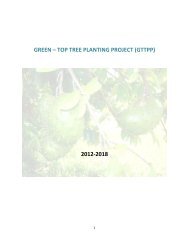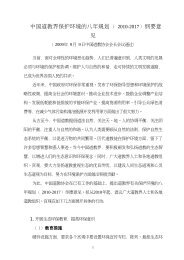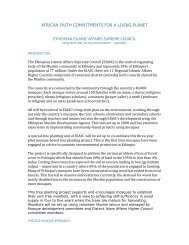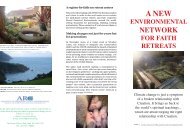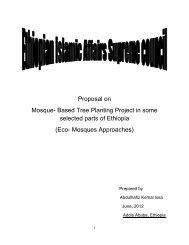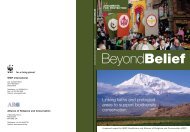summary paper - Alliance of Religions and Conservation
summary paper - Alliance of Religions and Conservation
summary paper - Alliance of Religions and Conservation
You also want an ePaper? Increase the reach of your titles
YUMPU automatically turns print PDFs into web optimized ePapers that Google loves.
These development programs will mean better food security, improved marketing through farmer<br />
cooperatives, adult literacy, community health care <strong>and</strong> a team <strong>of</strong> life to fight against HIV/AIDS.<br />
Chikweti means really developing local capacity.<br />
The Anglican Church <strong>of</strong> Mozambique is not an outside organization, NGO or service provider,<br />
We are a key community stake holder<br />
Living, working, laughing, crying, being striving together in community as community.<br />
Yes, there have been <strong>and</strong> are many challenges <strong>and</strong> difficulties:<br />
· Plantation agriculture<br />
· The introduction <strong>of</strong> exotic species<br />
· Use <strong>and</strong> ownership <strong>of</strong> l<strong>and</strong> <strong>and</strong> water resources<br />
· Onfarm labor shortages <strong>and</strong> food security<br />
· Gender <strong>and</strong> employment polices<br />
· Bureaucracy<br />
· Limited local capacity<br />
But, despite these obstacles, for us,<br />
Chikweti means a pr<strong>of</strong>essional wellrun, ethical, sustainable commercial, business investment;<br />
It means <strong>Conservation</strong> <strong>of</strong> Mozambique’s natural resources, <strong>and</strong><br />
It means Community Development to improve the lives <strong>of</strong> some <strong>of</strong> the poorest people in the world.<br />
For us, Chikweti is a step toward that dream <strong>of</strong> a better future.<br />
Imagine, it’s easy if you can.<br />
Aud V. Tønnessen<br />
Dr., Faculty <strong>of</strong> Theology, University <strong>of</strong> Oslo, Norway:<br />
‘Criteria for partnership. A gender perspective’<br />
Partnership has for a long time been a key word within development. “Today´s rule<strong>of</strong>thumb in<br />
international development is that everybody wants to be a partner with everyone else on everything,<br />
everywhere” Alan Fowler (2002) says (243). At the same time it is stated that “the talk <strong>of</strong> partnership <strong>of</strong>ten<br />
fails to address potential conflict <strong>and</strong> inequalities” (Crewe <strong>and</strong> Harrison 1998:87). What I will say today<br />
has to do with potential conflicts <strong>and</strong> why partnership with religious communities <strong>and</strong> faith groups should<br />
not be on everything, everywhere.<br />
Partnership has been an answer to two interrelated but different problems within development. On the<br />
one h<strong>and</strong> partnership is a description <strong>of</strong> a way <strong>of</strong> working. Instead <strong>of</strong>, say, a Norwegian development<br />
agency operating their own development project in another country, employing their own staff, a staff<br />
<strong>of</strong>ten consisting <strong>of</strong> a majority <strong>of</strong> expatriates, partnership means the agency is collaborating with one or<br />
more local organizations or groups that are responsible for a project or program. The roles are changed<br />
from donorrecipient to partners. And the terminology presupposes a collaboration the whole process<br />
through. It is no longer the donor telling the receiver what to do, since longtime experience from<br />
operational projects have taught that this seldom results in local ownership to the projects. Partnership is<br />
therefore a strategy to promote <strong>and</strong> secure local ownership, something seen as fundamental for<br />
sustainable development.<br />
On the other h<strong>and</strong> partnership is a normative way <strong>of</strong> describing an ideal relationship within development.<br />
As opposed to the donorreceiver relationship, partnership means a symmetric instead <strong>of</strong> an asymmetric<br />
relation, where the partners are mutually sharing responsibility <strong>and</strong> obligation. Instead <strong>of</strong> the paternalism<br />
<strong>of</strong> the operational model, partnership is seen as based on equality <strong>and</strong> a balance <strong>of</strong> power. Transparency<br />
must go both ways. Empirically though, it has been seriously questioned if partnership is any solution to<br />
paternalism. A Swedish study concluded that despite the partnership model, Swedish <strong>and</strong> Danish aid<br />
workers in Tanzania still maintained an image <strong>of</strong> themselves as representing the “reliable <strong>and</strong> trustworthy<br />
Western Self” whereas their local partners were seen as unpredictable <strong>and</strong> unreliable (Baaz 2005:167).<br />
At the same time the local partners did not experience the relationship as being based on mutual<br />
51



